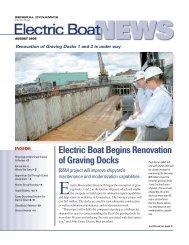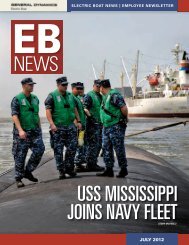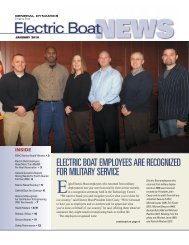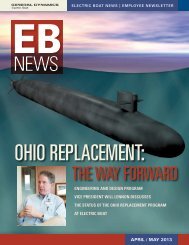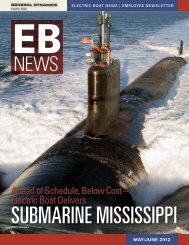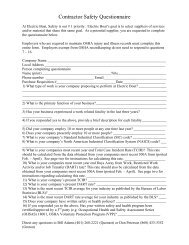EB news mar 04 - Electric Boat Corporation
EB news mar 04 - Electric Boat Corporation
EB news mar 04 - Electric Boat Corporation
You also want an ePaper? Increase the reach of your titles
YUMPU automatically turns print PDFs into web optimized ePapers that Google loves.
APRIL 2010<br />
SUBMARINE<br />
MISSOURI<br />
MARKS<br />
ANOTHER<br />
MILESTONE<br />
At 8 a.m. on Friday, April<br />
16, Sonar Technician<br />
Seaman Benjamin Bowers<br />
of Ionia, Mo., raised a flag<br />
over the Missouri (SSN-780) as<br />
Fire Control Technician 2nd<br />
Class Ryan Thruston of Jefferson<br />
City, Mo., saluted sharply.<br />
“It really gives you an appreciation<br />
for how much they have<br />
accelerated the build cycle,” to see<br />
the ship reaching ‘in-service’ so<br />
early, said Cmdr. Timothy<br />
Rexrode, who took command of<br />
Missouri July 10, 2009.<br />
In service means <strong>Electric</strong> <strong>Boat</strong><br />
transfers operational control to<br />
continued on page 10<br />
The sub<strong>mar</strong>ine Missouri (SSN-780)<br />
is placed in service earlier this month<br />
as members of the ship’s crew look on<br />
(upper left).<br />
INSIDE<br />
Navy Commissions USS New Mexico,<br />
Sixth Virginia-Class Sub<strong>mar</strong>ine • 2<br />
Welcome To <strong>Electric</strong> <strong>Boat</strong> • 3<br />
Marine Systems Roundup • 6<br />
General Dynamics Reports<br />
First-Quarter 2010 Results • 7<br />
Ethics • 10<br />
General Dynamics Appoints<br />
New Senior VP • 10<br />
Service Awards • 11<br />
Safety Performance • 12<br />
Retirees • 6<br />
Health Matters • 8/9
The sixth Virginia-class sub<strong>mar</strong>ine, USS New Mexico (SSN-779), was commissioned last month during a ceremony at Naval Station Norfolk. New Mexico will<br />
be homeported in Groton. In the background is USS George H. W. Bush (CVN-77).<br />
Navy Commissions USS New Mexico,<br />
Sixth Virginia-Class Sub<strong>mar</strong>ine<br />
USS New Mexico (SSN-779), the sixth sub<strong>mar</strong>ine of the Virginia Class, became the<br />
newest ship in the Navy’s fleet last month during a commissioning ceremony at Norfolk<br />
Naval Station.<br />
“USS New Mexico joining the Fleet is a testament to the hard work, ingenuity, and dedication of<br />
our superb shipbuilding partners at Northrop Grumman Shipbuilding and General Dynamics <strong>Electric</strong><br />
<strong>Boat</strong>," said Rear Adm. William Hilarides, program executive officer for sub<strong>mar</strong>ines. “Our shipbuilding<br />
team continues to deliver these tremendous boats ahead of schedule, and on budget.”<br />
Virginia-class sub<strong>mar</strong>ines are designed to dominate both littoral and deep waters, while conduct-<br />
continued on page 3<br />
2 I April 2010 I ELECTRIC BOAT NEWS
ing anti-sub<strong>mar</strong>ine; anti-surface ship; strike; special operation<br />
forces; intelligence, surveillance, and reconnaissance; irregular<br />
warfare; and mine warfare missions.<br />
“The commissioning of USS New Mexico continues the program's<br />
record of bringing capability to the Fleet ahead of schedule.<br />
As the construction rate ramps up to two sub<strong>mar</strong>ines per<br />
‘‘<br />
year starting in 2011, we begin to<br />
USS New Mexico joining the even more rapidly recapitalize the<br />
Navy's attack sub<strong>mar</strong>ine force. It's<br />
Fleet is a testament to the hard critical to maintain the two-per-year<br />
rate in order to achieve the Navy's<br />
work, ingenuity, and dedication<br />
force structure requirements,” said<br />
of our superb shipbuilding Capt. Michael Jabaley, Virginia-class<br />
program manager.<br />
partners at Northrop Grumman<br />
The commissioning was the most<br />
Shipbuilding and General recent in a series of Virginia-class<br />
events that occurred over the last<br />
Dynamics <strong>Electric</strong> <strong>Boat</strong>. Our<br />
year. These include California's<br />
shipbuilding team continues to (SSN-781) keel-laying ceremony<br />
May 1, 2009; USS Texas (SSN-775)<br />
deliver these tremendous boats<br />
completing the class's first Arctic<br />
ahead of schedule, and on Ocean testing in November 2009;<br />
’’<br />
the transfer of USS Hawaii (SSNbudget.<br />
776) and Texas to their new Pearl<br />
Harbor homeport in July and<br />
— Rear Adm. William Hilarides<br />
November 2009, respectively; and<br />
Program executive officer<br />
Missouri's (SSN-780) christening<br />
for sub<strong>mar</strong>ines<br />
ceremony Dec. 5, 2009. New Mexico<br />
was delivered Dec. 29, 2009, four months ahead of its contract<br />
delivery date.<br />
The commissioning of USS New Mexico was the first<br />
major sub<strong>mar</strong>ine event of 2010. Upcoming program events<br />
include the keel-laying ceremony for Mississippi (SSN-782)<br />
in June, and the delivery and commissioning of Missouri in<br />
June and July, respectively.<br />
Dan Barrett,<br />
Editor<br />
Bob Gallo,<br />
Gary Slater,<br />
Gary Hall,<br />
Photography<br />
<strong>Electric</strong> <strong>Boat</strong> News is<br />
published monthly by the<br />
Public Affairs Department,<br />
75 Eastern Point Road,<br />
Groton, CT 06340<br />
Phone (860) 433-8202<br />
Fax (860) 433-8054<br />
Email dbarrett@gdeb.com<br />
WELCOME TOELECTRIC BOAT<br />
Please help welcome the following<br />
employees, who have recently joined<br />
the company:<br />
330 Bryan Harris<br />
Lauren Swiatek<br />
Mary Wright<br />
412 Nathan Catania<br />
413 Michael Chonjnowski<br />
Chase Davis<br />
Miteshku<strong>mar</strong> Patel<br />
Philip Opaleski<br />
414 Brian Clark<br />
Catherine Cronk<br />
Adam Koppel<br />
Sean Zandan<br />
416 Nicholas Lau<br />
427 Timothy Chemacki<br />
Bryan Clodfelter<br />
Alexander Enwonwu<br />
Evan White<br />
428 Douglas Wiswell<br />
433 Arthur Clites<br />
Alexander Merlo<br />
Richard SeMon<br />
434 Jason Moreno<br />
435 Bryan McCormick<br />
448 Alden Wheeler<br />
449 Sarah Kelsall<br />
Kevin Sam<strong>mar</strong>tino<br />
462 Andrew Cass<br />
463 Andrew Rogers<br />
492 Paul Brewster<br />
493 Nicholas Behlman<br />
David Grant<br />
650 Edward Seymour<br />
Diana Spranklin<br />
660 Rachelle Cyr<br />
ELECTRIC BOAT NEWS I April 2010 I 3
From left, Pat Stevens, Rich Dennome, Joe Gross, Charlie Montalbano and Barry Lee. Not pictured: Mike Theriault.<br />
Process Improvement Aids Accuracy Control Group<br />
Most of us are familiar with<br />
what happens when our<br />
automobiles are not properly<br />
aligned. The steering wheel shakes.<br />
It becomes difficult to keep the car on<br />
the road. And the tires wear out quickly.<br />
In the sub<strong>mar</strong>ine business, alignment<br />
is a critical process in the construction<br />
and operation of the most complex<br />
machine on earth. <strong>Electric</strong> <strong>Boat</strong> has the<br />
tools and the people that form one of<br />
the most proficient accuracy-control<br />
groups in the shipbuilding industry.<br />
The Accuracy Control Group at <strong>EB</strong> is<br />
responsible for ensuring that hull sections<br />
are on target. When the joining of<br />
sections begins, group members establish<br />
cut lines to support the construction of<br />
piping, electrical and other systems critical<br />
to the operation of the ship. Torpedo-launch<br />
systems, another area of<br />
the ship where alignment is critical,<br />
require the utmost attention.<br />
Last summer, Supervisor Charlie Montalbano<br />
began considering methods to<br />
improve and evaluate requirements influencing<br />
the Accuracy Control organization.<br />
The procedures and systems supporting<br />
the process had become complex over<br />
time. Multiple computer systems were<br />
being used to manage the accuracy control<br />
liabilities, and the cost of generating<br />
an accuracy control or Shipyard Weld<br />
Statusing System (SWSS) report was<br />
increasing.<br />
Joe Gross, a new member of the<br />
Accuracy Control group, was busy<br />
bringing the drawing requirements for<br />
Accuracy Control through the normal<br />
process, loading SWSS information and<br />
other data, while receiving on-the-job<br />
training from co-workers Rich Dennome<br />
and Barry Lee.<br />
Gross, who previously worked in<br />
planning developing Virginia-class work<br />
methods, noticed a significant contrast<br />
between SWSS lines loading in the planning<br />
group and the method used by<br />
Accuracy Control.<br />
This was the impetus behind an effort<br />
to find a better way – in this case, a<br />
4 I April 2010 I ELECTRIC BOAT NEWS
Otto Bode at his Quonset Point office.<br />
process improvement project to streamline<br />
Accuracy Control’s electronic database.<br />
The objectives: select the Accuracy<br />
Control outputs with the highest potential<br />
for savings; reduce span time by modifying<br />
an Accuracy Control construction<br />
procedure data sheet; reduce the cost of<br />
revisions from six hours to two hours and<br />
reduce revision A costs from 13.5 hours<br />
to 8.75 hours by December 2009.<br />
With a Lean Six Sigma Green Belt<br />
training class about to begin, the timing<br />
couldn’t have been better. Gross was<br />
assigned a seat in the class. “When I saw<br />
that Charlie Montalbano was the process<br />
owner I didn’t hesitate to reserve a seat,”<br />
said Deneen Thaxton, director of Process<br />
Engineering. “Charlie has always worked<br />
closely with Process Engineering, so we<br />
knew this was going to be a worthwhile<br />
investment.”<br />
Green Belts in training typically work<br />
in pairs. For this project, ventilation<br />
draftsman Pat Stevens was paired with<br />
Gross.<br />
The two trainees quickly learned how<br />
challenging the first team meeting can be.<br />
Dennome recalled, “The first meeting<br />
was very awkward, with strong personalities<br />
in the room, sidebar discussions taking<br />
place, and nervousness about the outcome,”<br />
Dennome said. “We were convinced<br />
that the current process was OK,<br />
and we challenged the trainees’ abilities.”<br />
Mike Theriault, a team member on the<br />
project, provided some background on<br />
the old process.<br />
“At the start of the Virginia-class program<br />
we developed drawing rules based<br />
on the way we were doing business. Back<br />
then we didn’t have the ability to see the<br />
non-value added steps that were being<br />
instituted into the process. Until this<br />
project, we always managed that extra<br />
baggage despite the fact it was adding no<br />
value to the job at hand,” he said. By following<br />
the structured Lean Six Sigma<br />
methodology, however, the team was able<br />
to clearly understand the inner workings<br />
of the process then in place. “The structured<br />
approach was beneficial,” he said.<br />
In another step to ensure success, Otto<br />
Bode and Steve Donohue from Quonset<br />
Point were contacted for their services<br />
because of the integral roles they played<br />
in this process.<br />
“This project transformed the process<br />
by eliminating the non-value added<br />
steps,” said Bode. “We can make changes<br />
faster to support construction now that<br />
the unnecessary steps are gone.”<br />
The involvement of the Green Belts<br />
Gross and Stevens was another important<br />
factor in the success of the effort.<br />
“With their facilitation and process mapping<br />
skills, Joe and Pat helped the team<br />
understand the bottlenecks in the existing<br />
process and where the opportunities<br />
to eliminate those bottlenecks existed,”<br />
said Lee.<br />
According to Dennome, “This process<br />
improvement sets the stage for the next<br />
ship design by eliminating much of the<br />
paper previously generated on Virginia<br />
Class. This was a minor change for Virginia<br />
Class, but it will be very important<br />
to the shipyard when we go to two boats<br />
per year.”<br />
When asked to describe the highlight<br />
of the project, Gross replied, “The day<br />
we completed the project and issued the<br />
directive to stop generating the non-value<br />
added paperwork and associated data<br />
entry made it clear to me the objective<br />
was met.”<br />
Stevens added, “The experience of<br />
working this project was very rewarding.<br />
As a relatively new MDA-represented<br />
employee, I recognized that working with<br />
this team was a rare opportunity. I can<br />
bring what I learned from this experience<br />
back into design.”<br />
Jeff Bregitzer, a Black Belt in Process<br />
Engineering and the mentor assigned to<br />
assist Gross and Stevens, provided his<br />
perspective: “This team did an exceptional<br />
job at completing the project.<br />
They met their objectives, and were great<br />
to work with.”<br />
Most importantly, said Montalbano.<br />
“This project brought the Quonset Point<br />
and Groton Accuracy Control groups a<br />
little bit closer.<br />
“Traditionally it’s hard to introduce<br />
change,” he said. “The Lean Six Sigma<br />
tools and this project showed everyone<br />
that change can happen, and that it can<br />
happen quickly and relatively easily. The<br />
team did a great job.”<br />
ELECTRIC BOAT NEWS I April 2010 I 5
Retirees<br />
226 William E. Crowley<br />
46 years<br />
Shipfitter 1/C<br />
251 Albert J. Daniels<br />
33 years<br />
Painter 1/C<br />
355 Jerome J. Chadwick<br />
37 years<br />
Planning Specialist<br />
355 Karen A. Papajohn<br />
33 years<br />
Prod Planner<br />
410 Curtis W. Olsen<br />
11 years<br />
Engineer Senior<br />
412 Francis B. Pendola<br />
35 years<br />
Engineer Senior<br />
438 John W. Schmidt<br />
31 years<br />
Engineer, Principal<br />
454 Peter J. Salmoiraghi<br />
37 years<br />
Engineer, Principal<br />
496 Michael J. Coombs<br />
34 years<br />
T/A Weight Estimator<br />
605 David F. Tela<br />
27 years<br />
Public Affairs Sr Spec<br />
915 Henry A. Knight III<br />
29 years<br />
M/T Tech II<br />
921 Paul J. Herchen<br />
35 years<br />
Foreman<br />
933 Ronald J. Arruda<br />
41 years<br />
Matl Svc Rep I<br />
935 Wayne A. Proulx<br />
35 years<br />
Prod Supp Tech I<br />
MARINE SYSTEMS NEWS<br />
<strong>Electric</strong> <strong>Boat</strong> Receives $37 Million for USS Hartford Repair Work<br />
The U.S Navy has awarded <strong>Electric</strong> <strong>Boat</strong> a $36.6 million contract modification for repair work on<br />
USS Hartford (SSN-768), a Los Angeles-class sub<strong>mar</strong>ine damaged in a collision in March 2009.<br />
Under the modification, <strong>Electric</strong> <strong>Boat</strong> will continue work on the complete restoration of USS Hartford,<br />
including fabrication and installation of a hull patch, bridge-access trunk, port retractable bow<br />
plane and the sail. In addition, <strong>Electric</strong> <strong>Boat</strong> will perform selected maintenance work on the sub<strong>mar</strong>ine.<br />
If all options are exercised and funded, the total value of the contract will be $86.9 million.<br />
Navy Awards <strong>Electric</strong> <strong>Boat</strong> $10M for Sub Maintenance<br />
and Modernization Work<br />
<strong>Electric</strong> <strong>Boat</strong> has received a $10.2 million contract modification from the Navy to perform maintenance<br />
and modernization work on the USS Miami (SSN-755), a Los Angeles-class attack sub<strong>mar</strong>ine.<br />
Under the terms of the contract, <strong>Electric</strong> <strong>Boat</strong> will perform a Docking Continuous Maintenance<br />
Availability, which consists of repairs, maintenance work, alterations and testing. The work will take<br />
place at the Groton shipyard and involve more than 200 employees at its peak. Scheduled for completion<br />
by August 2010, the contract will be worth $12.2 million if all options are exercised and funded.<br />
NASSCO Lays Keel of the USNS William McLean<br />
SAN DIEGO – General Dynamics NASSCO recently laid the keel for USNS William McLean, the<br />
12th ship of the Lewis and Clark class of dry cargo-ammunition ships (T-AKE). The ship is named in<br />
honor of the U.S. Navy physicist who in the 1950s pioneered the technology behind the Sidewinder<br />
missile, the first effective U.S. air-to-air missile.<br />
Construction of the William McLean began in September 2009. NASSCO is scheduled to deliver<br />
the ship to the Navy in the third quarter of 2011. When it joins the fleet, the William McLean will be<br />
used pri<strong>mar</strong>ily to stage U.S. Marine Corps equipment abroad by the Navy’s Military Sealift Command.<br />
The San Diego shipyard has already delivered nine T-AKE ships to the Navy and is under contract to<br />
build five additional ships, including the William McLean, for a total class of 14 T-AKE vessels.<br />
NASSCO Starts Construction of the USNS Medgar Evers<br />
SAN DIEGO – General Dynamics NASSCO has begun construction of the future USNS Medgar<br />
Evers, the thirteenth ship of the U.S. Navy’s T-AKE program.<br />
The Medgar Evers is named in honor of the U.S. Army veteran and civil rights pioneer from Mississippi.<br />
The ship is scheduled to be delivered to the Navy in the second quarter of 2012.<br />
Bath Iron Works Awarded $16 Million for DDG-1001<br />
Advanced Material Procurement and Support<br />
BATH, Maine – The U. S. Navy has awarded Bath Iron Works a $15.9 million modification to a previously<br />
awarded contract for procurement of long-lead material and engineering, production and<br />
related -support services associated with the construction of DDG-1001.<br />
The original contract was awarded in February 2008. Work encompassed by this modification is<br />
expected to be completed by July 2010.<br />
BIW President Jeff Geiger said, “The Navy’s execution of this contract modification is a sign of their<br />
confidence in what we are doing and the progress that we are making on the DDG-1000 program.”<br />
6 I April 2010 I ELECTRIC BOAT NEWS
General Dynamics Reports First-Quarter 2010 Results<br />
Earnings from continuing operations increase to $599 million<br />
Company-wide operating <strong>mar</strong>gins increase to 11.8 percent<br />
FALLS CHURCH, Va.<br />
General Dynamics has reported<br />
first-quarter 2010 earnings<br />
from continuing operations of<br />
$599 million, or $1.54 per share on a fully<br />
diluted basis, compared with 2009 firstquarter<br />
earnings from continuing operations<br />
of $593 million, or $1.54 per share<br />
fully diluted. Revenues in the quarter<br />
were $7.75 billion. Net earnings for the<br />
first quarter of 2010 were $597 million,<br />
compared to $590 million in the first<br />
quarter of 2009.<br />
Margins<br />
Company-wide operating <strong>mar</strong>gins for<br />
the first quarter of 2010 were 11.8 percent,<br />
compared to 11 percent in the yearago<br />
period. Aerospace and Combat Systems<br />
<strong>mar</strong>gin growth was especially<br />
strong, increasing by 240 basis points and<br />
180 basis points, respectively.<br />
Backlog<br />
Funded backlog at the end of firstquarter<br />
2010 grew to $47.4 billion, a 3<br />
percent increase over the end of the<br />
fourth quarter 2009. Significant orders<br />
received include contracts valued at $845<br />
million for construction of two additional<br />
T-AKE combat-logistics ships and<br />
$115 million for construction materials<br />
for an additional DDG-51 destroyer for<br />
the U.S. Navy, and $515 million for<br />
Stryker vehicle production and support<br />
for the U.S. Army. The Information Systems<br />
and Technology group was awarded<br />
a contract valued at $340 million to initiate<br />
production of the second increment<br />
of Army’s next-generation on-the-move<br />
tactical battlefield network, called WIN-<br />
T. The Aerospace group saw strong order<br />
activity in the quarter, particularly among<br />
large-cabin Gulfstream aircraft.<br />
The company’s total backlog at the end<br />
of the first quarter 2010 was $63.9 billion,<br />
and the estimated potential contract<br />
value was an additional $17 billion,<br />
which represents management’s estimate<br />
of value under unfunded indefinite delivery,<br />
indefinite quantity (IDIQ) contracts<br />
and unexercised options.<br />
Cash<br />
Net cash provided by operating activities<br />
in the quarter totaled $210 million.<br />
Free cash flow from operations, defined<br />
as net cash provided by operating activities<br />
less capital expenditures, was $150<br />
million for the period.<br />
“General Dynamics delivered a strong<br />
operational performance in the first quarter<br />
of 2010,” said Jay L. Johnson, president<br />
and chief executive officer. “Operating<br />
<strong>mar</strong>gins across the company were<br />
steady or improving, demonstrating the<br />
benefits of our commitment to continuous<br />
improvement, and we saw good order<br />
activity across the corporation. On balance,<br />
General Dynamics delivered solid<br />
results, giving us a good first step down<br />
the path toward meeting our overall performance<br />
objectives for the year,” Johnson<br />
said.<br />
FIRST QUARTER 2010<br />
SIGNIFICANT ORDERS<br />
(UNAUDITED)<br />
Dollars in millions<br />
We received the following significant contract<br />
orders during the first quarter of 2010:<br />
Combat Systems<br />
Approximately $515 from the U.S.<br />
Army for vehicle production, contractor<br />
logistics support and battle-damage<br />
assessment under the Stryker wheeled<br />
armored vehicle program.<br />
Approximately $300 from the U.S.<br />
Marine Corps under the mine-resistant,<br />
ambush-protected (MRAP) vehicle program<br />
to provide 250 RG-31 vehicles, suspension<br />
kits and spare parts.<br />
Approximately $100 from the Army<br />
to provide improved ribbon bridge (IRB)<br />
bays and accessories.<br />
Marine Systems<br />
Approximately $845 from the U.S.<br />
Navy for the construction of the 13th<br />
and 14th T-AKE combat-logistics ships,<br />
scheduled for delivery in 2012.<br />
Approximately $115 from the Navy<br />
for long-lead material for the construction<br />
of an additional DDG-51 Arleigh<br />
Burke-class destroyer.<br />
Approximately $65 from the Navy to<br />
continue to provide Advance Nuclear<br />
Plant Studies (ANPS) in support of hull,<br />
mechanical, and electrical (HM&E) systems.<br />
The award has a maximum potential<br />
value of $185.<br />
Information Systems<br />
and Technology<br />
Approximately $390 from the Army<br />
under the Warfighter Information Network-Tactical<br />
(WIN-T) program for<br />
Increment 1 satellite communication<br />
equipment and low rate initial production<br />
of Increment 2 equipment.<br />
Approximately $165 of orders for<br />
ruggedized computing and networking<br />
equipment under the Common Hardware/Software<br />
III (CHS-3) program,<br />
bringing the total contract value to more<br />
than $2.1 billion.<br />
Approximately $110 for the Joint Tactical<br />
Radio System (JTRS) Handheld,<br />
Manpack and Small Form-Fit (HMS)<br />
radio program, bringing the total contract<br />
value to approximately $685.<br />
Approximately $25 from the Army for<br />
Constructive Training Systems support.<br />
This five-year IDIQ contract has a maximum<br />
potential value of approximately $390.<br />
Approximately $30 from the Army to<br />
support the Medical Communications for<br />
Combat Casualty Care (MC4) Product<br />
Management Office. The contract has a<br />
maximum potential value of approximately<br />
$150 over five years.<br />
ELECTRIC BOAT NEWS I April 2010 I 7
HEALTH<br />
MATTERS<br />
Bob Hurley, MD<br />
Medical Director<br />
The Eye<br />
As you may have guessed, it’s<br />
difficult to examine the eye.<br />
Like many doctors, I experience<br />
a glare formed from the cornea<br />
and other layers of the eye, which act<br />
like mirrors, reflecting light back at the<br />
examiner. The bright light of the hand<br />
held ophthalmoscope results in small<br />
pupils which limits the evaluation.<br />
Fortunately, we have the slit lamp, a<br />
device that we (unfortunately) use<br />
nearly every day to evaluate the extent<br />
of eye injuries that present to the Yard<br />
Hospital.<br />
The inventor of the slit lamp, Allvar<br />
Gullstrand, M.D. (1862-1930), won<br />
the Nobel Prize in Physiology and<br />
Medicine in 1911. Gullstrand used his<br />
understanding of the physiology of the<br />
eye and devised the optics for a new<br />
microscope. It incorporated two<br />
important advances – far more intense<br />
light and sharp focus of the beam, and<br />
the separation of illumination from the<br />
observation of the examiner. In testimony<br />
to his achievement, the slit lamp<br />
is an instrument that is still used in<br />
every ophthalmologist's office today.<br />
Avoiding the Slit lamp<br />
Eye injuries of all types occur at a<br />
rate of more than 2,000 per day. In<br />
particular, an estimated 1,000 eye<br />
injuries occur in American workplaces<br />
alone. The Bureau of Labor Statistics<br />
(BLS) found that almost 70 percent of<br />
the eye injuries studied occurs from<br />
falling or flying objects, or sparks<br />
striking the eye. Under the Healthy<br />
People 2010 program, the nation’s official<br />
public health agenda, the U.S.<br />
Department of Health and Human<br />
Services hopes to cut workplace eye<br />
injuries by up to a third over the<br />
course of this decade.<br />
The best way to prevent eye injury is<br />
to always wear appropriate eye protection.<br />
The BLS reports that approxi-<br />
mately three out of every five workers<br />
injured were either not wearing eye<br />
protection at the time of the accident<br />
or wearing the wrong kind of eye protection<br />
for the job. To be effective, eyewear<br />
must fit properly and be designed<br />
to effectively protect workers while<br />
they work. It is estimated that more<br />
than 90 percent of eye injuries could<br />
be prevented by the use of proper<br />
safety eyewear.<br />
On the Home Court<br />
A recent national survey by the<br />
American Academy of Ophthalmology<br />
found that only 35 percent of<br />
respondents said they always wear<br />
protective eyewear when performing<br />
home repairs or maintenance; even<br />
fewer do while playing sports.<br />
Sports and recreational activities<br />
cause more than 40,000 eye injuries<br />
each year and most of these are preventable.<br />
The majority of eye injuries<br />
occur in persons under 30 years of age.<br />
Children are especially vulnerable as<br />
they often have underdeveloped depth<br />
perception and may have difficulty<br />
judging the position of a flying ball.<br />
It’s not uncommon for a child to misjudge<br />
a ball in flight, miss it, and take<br />
a blow to the face instead. Basketball<br />
and baseball cause the most eye<br />
injuries, followed by water sports and<br />
racquet sports.<br />
Types of Injury<br />
Sports-induced eye injuries range in<br />
severity from mild scrapes of the<br />
cornea to severe trauma that can cause<br />
visual impairment or even blindness.<br />
Three types of eye trauma can result<br />
from sports injuries: corneal abrasion,<br />
blunt injuries and penetrating injuries.<br />
Corneal abrasion is a scrape of the<br />
outer surface of the eye. It is usually is<br />
painful but not severe. In sports and<br />
recreation, the most common cause, is<br />
8 I April 2010 I ELECTRIC BOAT NEWS
a scratch from a fingernail.<br />
Blunt injuries occur when impact<br />
from an object (tennis ball, racquet,<br />
fist, elbow, etc.) causes sudden compression<br />
of the eye. Mild blunt injuries<br />
sometimes only result in bleeding of<br />
the eyelids or a black eye. Also, a subconjunctival<br />
hemorrhage may develop.<br />
This involves bleeding from the delicate<br />
blood vessels of the conjunctiva,<br />
which lie on top of the white outer<br />
coat of the eye. Neither of these types<br />
of bleeding poses a threat to the eye<br />
itself. However, these injuries may be<br />
seen in more severe cases in which the<br />
eye is damaged. As symptoms of<br />
severe injury are not always obvious, it<br />
is crucial that all cases of eye trauma<br />
are thoroughly examined by an ophthalmologist.<br />
One of the common results of more<br />
severe blunt trauma is bleeding in the<br />
front of the eye between the clear<br />
cornea and colored iris. This condition<br />
is known as a hyphema. In addition,<br />
blunt injury may cause a cut or tear of<br />
the eyelids, which may need special<br />
suturing. Also, the bony walls surrounding<br />
the eye may be fractured by<br />
severe blunt trauma. Severe blunt<br />
trauma also may damage important<br />
structures inside the eye, such as the<br />
retina or optic nerve, resulting in<br />
potentially permanent visual loss.<br />
Therefore, if you suffer a blunt injury<br />
to the eye, see an ophthalmologist as<br />
soon as possible.<br />
Penetrating injuries occur when a<br />
foreign object pierces the eye. A common<br />
cause of these injuries in children<br />
is BB pellets. Also, a piece of glass<br />
from spectacles shattered during sports<br />
play sometimes can penetrate the eye.<br />
Penetrating injuries often cause severe,<br />
sight-threatening damage. They are<br />
true emergencies and must be evaluated<br />
promptly by an ophthalmologist.<br />
Eye injuries of all types occur at a<br />
rate of more than 2,000 per day.<br />
In particular, an estimated 1,000<br />
eye injuries occur in American<br />
workplaces alone.The Bureau of<br />
Labor Statistics (BLS) found that<br />
almost 70 percent of the eye<br />
injuries studied occurs from falling<br />
or flying objects, or sparks striking<br />
the eye.<br />
Warning Signs<br />
The warning signs of potentially<br />
serious eye injury include:<br />
Visual loss<br />
Bleeding on the surface or inside<br />
the eye<br />
Tears in the outer ocular walls<br />
A foreign body inside the eye<br />
The evaluation of sports-related eye<br />
injuries is the same as for other types of<br />
eye trauma. More emergent injuries,<br />
such as head trauma with loss of consciousness,<br />
are always treated first.<br />
Treatment<br />
Prompt first aid after eye injury may<br />
greatly improve the chance of preserving<br />
vision. The recommended first aid<br />
involves placing a protective cover over<br />
the eye to prevent further damage. (If<br />
no shield is available, tape the bottom<br />
of a paper cup over the eye.) Seek<br />
emergency care as soon as possible.<br />
The type of treatment given depends<br />
on the injury. Surgery may be required<br />
to repair blunt or penetrating injuries.<br />
Prevention<br />
The best way to prevent an eye<br />
injury while involved in sports and<br />
recreation is to wear specially designed<br />
protective eyewear. While these eye<br />
guards cannot eliminate risk, they<br />
greatly reduce the chance of ocular<br />
injury. Regular eyeglasses and contact<br />
lenses do not offer adequate protection<br />
from sports injuries. Glass lenses may<br />
even shatter and cut the eye.<br />
If your child plays any one of a<br />
number of sports you need to know<br />
that it is up to you to protect their eyesight<br />
by purchasing and ensuring they<br />
wear eye protection when they play<br />
sports. Many children's sports leagues,<br />
schools and teams don't require children<br />
to wear eye protection. Parents<br />
must insist that children wear eye protection<br />
every time they play and set a<br />
good example by wearing eye protection<br />
themselves whenever they play.<br />
In collision sports, total head and<br />
face protection is essential. A helmet in<br />
football and a face mask in hockey<br />
with built-in eye protection should be<br />
worn. In hockey the risk of eye injury<br />
is not so much from collision as from a<br />
flying puck. The standardization and<br />
use of face masks in amateur Canadian<br />
ice hockey reduced eye injuries by<br />
66 percent.<br />
Today, the standard eye guard<br />
designed for use at work and in sports<br />
such as racquetball, baseball and basketball<br />
is made of polycarbonate plastic.<br />
It’s recommended that protective<br />
eye wear be properly fitted by an eyecare<br />
professional. Avoid open lenses, as<br />
a small ball traveling at high speed can<br />
be compressed through the opening<br />
and cause severe eye damage. Specific<br />
eyewear is available for just about all<br />
activities.<br />
So, if you want to avoid being evaluated<br />
by Dr. Gullstrand’s slit lamp<br />
device, I’d recommend that you wear<br />
appropriate eyewear for your activity.<br />
ELECTRIC BOAT NEWS I April 2010 I 9
General Dynamics<br />
Appoints New Senior<br />
VP of Planning and<br />
Development<br />
General Dynamics has appointed Robert W. Helm<br />
as senior vice president of planning and development,<br />
reporting to Jay L. Johnson, president and<br />
chief executive officer.<br />
In this position, Helm will be responsible for Government<br />
Relations, Strategic Planning, International Business Analysis<br />
and Compliance, Investor Relations and Communications.<br />
He will replace Phebe N. Novakovic, who has been appointed<br />
executive vice president of the company’s Marine Systems<br />
group.<br />
Helm was with Northrop Grumman Corp. for 21 years,<br />
most recently serving as corporate vice president for Government<br />
Relations. Prior to joining Northrop Grumman, he was<br />
vice president of business development, Space and Aviation<br />
Systems, with Honeywell Inc. Helm served as the assistant<br />
secretary of defense (controller) from 1984 until 1988. He was<br />
a White House staff member on the National Security Council<br />
during the Reagan administration and also served as the<br />
senior national security professional staff member on the U.S.<br />
Senate Budget Committee.<br />
<strong>EB</strong> Business Ethics<br />
and Conduct<br />
INTERNET USE<br />
Supervisors and managers may permit internet use<br />
during non-working periods. However, internet access<br />
should not be used to support a personal business or<br />
political venture, violate any of the standards in the Blue<br />
Book, or in any way be an embarrassment to <strong>Electric</strong><br />
<strong>Boat</strong> or General Dynamics.<br />
You may never use the company’s internet access to<br />
view, send or forward information that is sexually<br />
explicit, discriminatory, derogatory, illegal, profane or<br />
abusive.<br />
<strong>Electric</strong> <strong>Boat</strong> may monitor or filter internet use in<br />
order to maintain and enforce company standards.<br />
Be reminded that it is the responsibility of each<br />
employee to report internet concerns or abuse to his/her<br />
supervisor, manager, union steward or the Human<br />
Resources department.<br />
<strong>EB</strong> Ethics Director Frank Capizzano (860-433-1278)<br />
is available to assist anyone regarding questions or issues<br />
that may relate to ethical decision making. The GD<br />
Ethics Hotline is available 24/7 and may be reached at<br />
800-433-8442 or 700-613-6315 for international callers<br />
Remember – when in doubt, always ask.<br />
MISSOURI continued from page 1<br />
the Fleet Commander, and the crew becomes responsible for the<br />
safety and security of the ship.<br />
“Today’s our first day to be a ship,” Rexrode said.<br />
It was a momentous day for the shipbuilders as well.<br />
“For the last 60 months we’ve been focused on building the<br />
ship,” said Ship’s Manager Mike Nowak. “Then you come to a<br />
day like today, when the flag goes up for the first time. It’s a little<br />
bit of a different mindset than it has been. It reminds us it’s<br />
really turning into a warship. There’s pride on the part of the<br />
entire <strong>EB</strong> workforce, particularly on the part of the people who<br />
built it.”<br />
But even with placing the ship in-service, and the delivery soon<br />
after sea trials, there’s not a lot of time to rest, Nowak said.<br />
“There’s another ship in small pieces now that we’ll have to go<br />
to after delivery,” Nowak said. “We look forward to that and to<br />
doing it a little bit better.”<br />
Missouri, which was more complete at floatoff last year (90<br />
percent) than any previous ship of its class, was declared in service<br />
in its 60th month of construction, which shatters all previous<br />
records for the class.<br />
Next up are sea trials. Delivery is expected this spring, eight<br />
months earlier than any previous Virginia-class sub<strong>mar</strong>ine, and<br />
about 10 months ahead of its contract delivery date of April 30,<br />
2011.<br />
“It’s a proud moment. We’ve come a long way,” said Foreman<br />
Ronald R. LaBrecque (244).<br />
“It’s a big deal to get to this point,” said Corey W. Estabrooks<br />
(251), “especially after you’ve seen the ship come in one piece at<br />
a time.”<br />
10 I April 2010 I ELECTRIC BOAT NEWS
ServiceAwards<br />
50 years<br />
414 William W. Fitzgerald<br />
45 years<br />
428 William S. Litwin<br />
40 years<br />
403 Warren P. Lewis<br />
35 years<br />
221 Arlene D. Allard<br />
229 Shane A. Hodges<br />
229 John W. Nelkin<br />
229 Paul M. Turner<br />
244 George M. Murno<br />
320 Harold F. Ainscough<br />
355 Steven D. Rayhill<br />
4<strong>04</strong> Michael A. Trynosky<br />
435 John P. Foley<br />
438 William L. Grenon<br />
459 Gary S. Hall<br />
496 David L. Champagne<br />
633 David J. Medeiros<br />
663 John F. Swidrak<br />
924 Donald G. Horton<br />
935 Robert J. Fitz<br />
935 Gary I. Smith<br />
957 Suzanne M. Lavoie<br />
957 Joseph L. Snow<br />
230 John W. Pannoni<br />
428 Lorraine M. Laverdure<br />
431 Armand L. Allen Jr.<br />
433 Peter J. Adams<br />
446 Robert E. Harding<br />
452 Michael Jensen<br />
459 Bonnie A. Bailey<br />
492 Stephen B. Swan<br />
494 Andrew J. Bliss<br />
507 Denise P. Lusk-Connell<br />
601 William P. Lennon<br />
626 Robert J. Regan<br />
642 Thomas J. Perrone<br />
901 Richard A. Riebe<br />
902 William Rego Jr.<br />
902 George A. Tabele Jr.<br />
9<strong>04</strong> Dean R. Pendleton<br />
915 David J. Woodard<br />
933 Charles H. Bagley Jr.<br />
935 Michael J. Ormond<br />
962 Paul N. Lamoureux<br />
100 Robert M. Horne<br />
210 Denise A. Dostoler<br />
226 David C. Bridges<br />
410 Sandra C. Gabarra<br />
419 Mark J. Schroeder<br />
437 John E. Bozenhard<br />
438 Craig S. Ardel<br />
449 David A. Peikes<br />
452 James M. Carter Jr.<br />
452 Cheryl J. Vars<br />
460 Michele T. Allen<br />
472 Steven M. Huston<br />
473 Mark S. Cika<br />
610 David E. Johnson<br />
641 Terence J. Fedors<br />
686 Tyrone R. Lawton<br />
702 James B. Cornwall Jr.<br />
911 Raymond C. Walker<br />
921 Donald J. Langlais<br />
935 Robert A. Cournoyer<br />
30 years 25 years 20 years<br />
230 Lawrence A. Williams<br />
252 Lawrence R. Grills<br />
333 Richard G. Myshka<br />
428 Christopher P. Roddy<br />
443 Paul H. Heller<br />
459 William N. Downie Jr.<br />
459 James F. Flyntz<br />
459 Joseph J. Scott<br />
686 Thomas C. Berl<br />
686 Jonathan L. Lathrop<br />
901 Gary M. Fox<br />
933 Deborah A. Lussier<br />
962 Joseph Demoura Jr.<br />
ELECTRIC BOAT NEWS I April 2010 I 11
SEPT<br />
STANDARD PRESORT<br />
U.S. POSTAGE<br />
P A I D<br />
GROTON, CT<br />
PERMIT NO. 392






